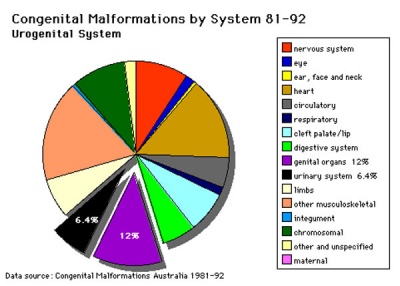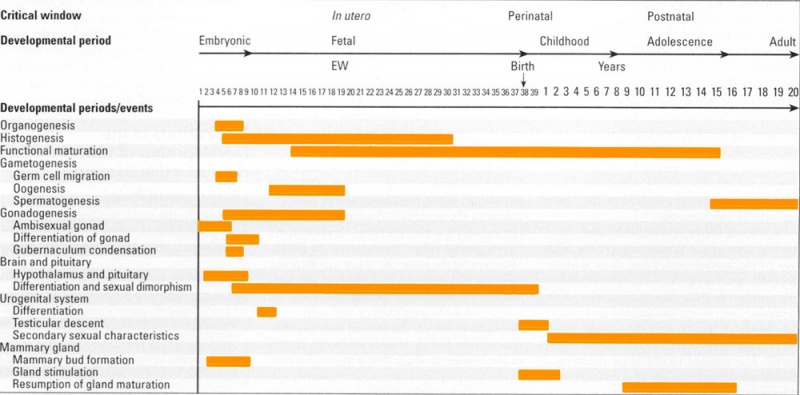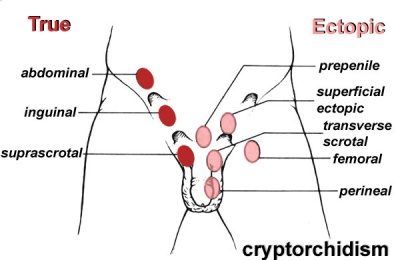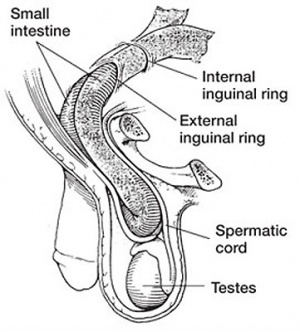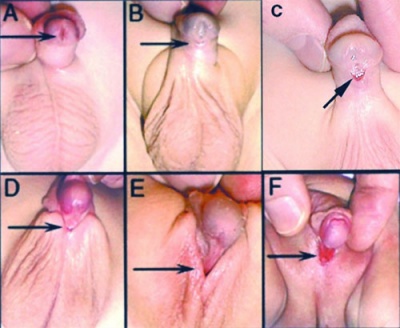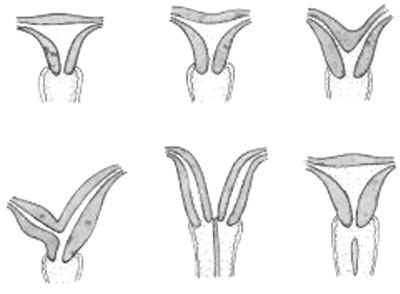2011 Lab 8 - Genital Abnormalities
| 2011 Lab 8: Introduction | Sex Determination | Early Embryo | Late Embryo | Fetal | Postnatal | Abnormalities | Quiz | Online Assessment |
Reproductive Abnormalities
Critical Periods
Gonadal Descent
External Genitalia
Internal Genitalia
Male
- Ductus Deferens - unilateral or bilateral absence congenital unilateral absence of the vas deferens (CUAVD), Congenital bilateral absence of the vas deferens (CBAVD)
failure of mesonephric duct to differentiate frequent cause of obstructive azoospermia 75% of men with bilateral absence have at least one detectable common mutation in the cystic fibrosis transmembrane conductance regulator (CFTR) gene
Female
Additional Information
Disorders of Sex Development
The previous human sex development terminology (true hermaphrodites, male pseudohermaphrodites and female pseudohermaphrodites) are considered outdated and stigmatising and have been replaced with the general term Disorders of Sex Development (DSD) established by the Consensus statement on management of intersex disorders.[1] See also the Medical Journal of Australia 2009 editorial article.[2]
| Previous Terminology | New Proposed Terminology |
| Intersex | DSD |
| Male pseudohermaphrodite, undervirilization of an XY male, and undermasculinization of an XY male | 46,XY DSD |
| Female pseudohermaphrodite, overvirilization of an XX female, and masculinization of an XX female | 46,XX DSD |
| True hermaphrodite | Ovotesticular DSD |
| XX male or XX sex reversal | 46,XX testicular DSD |
| XY sex reversal | 46,XY complete gonadal dysgenesis |
Hypospadia
| Hypospadia Classification | Meatus Opening |
| Anterior | on inferior surface of glans penis |
| Coronal | in balanopenile furrow |
| Distal | on distal third of shaft |
| Penoscrotal | at base of shaft in front of scrotum |
| Scrotal | on scrotum or between the genital swellings |
| Perineal | behind scrotum or genital swellings |
- Epispadias - Uncommon abnormality associated with the penis, 1 in 30,000 infant males, external urethral opening on the dorsal surface of penis.
- Cryptorchidism in common eutherian mammals.[3]- Species comparison of descent timeline
- Mayer-Rokitansky syndrome (MRK anomaly, Rokitansky-Küster-Hauser syndrome, RKH syndrome, RKH) congenital absence of the vagina, dyspareunia, vaginal agenesis.
Polycystic Ovary Syndrome
(PCOS) or Stein–Leventhal syndrome (1930s researchers) a metabolic syndrome with many other symptoms, ovarian cysts arise through incomplete follicular development or failure of ovulation. For review see [4]
Environmental Abnormalities
- Diethylstilbestrol (DES or diethylstilbetrol) - is a drug that was prescribed to women from 1938-1971 to prevent miscarriage in high-risk pregnancies.
- The drug acted as a potent estrogen (mimics natural hormone) and therefore could also act as a potential endocrine disruptor.
- This led to a number of developing fetal reproductive tract and other abnormalities.
- In the female fetus, it increased risk of abnormal reproductive tract and also carcinogenic (cancer forming).
- In the male fetus, it increased the occurance of abnormal genitalia.
- The drug was banned by FDA (USA) in 1979 as a teratogen, it had previously also been used as livestock growth promoter and could have potentially entered the human food chain.
References
- ↑ <pubmed>16882788</pubmed>| Pediatrics.
- ↑ <pubmed>19485836</pubmed>| Med J Aust.
- ↑ <pubmed>17379650</pubmed>
- ↑ <pubmed>14748678</pubmed>
| 2011 Lab 8: Introduction | Sex Determination | Early Embryo | Late Embryo | Fetal | Postnatal | Abnormalities | Quiz | Online Assessment |
Glossary Links
- Glossary: A | B | C | D | E | F | G | H | I | J | K | L | M | N | O | P | Q | R | S | T | U | V | W | X | Y | Z | Numbers | Symbols | Term Link
Cite this page: Hill, M.A. (2024, April 28) Embryology 2011 Lab 8 - Genital Abnormalities. Retrieved from https://embryology.med.unsw.edu.au/embryology/index.php/2011_Lab_8_-_Genital_Abnormalities
- © Dr Mark Hill 2024, UNSW Embryology ISBN: 978 0 7334 2609 4 - UNSW CRICOS Provider Code No. 00098G
